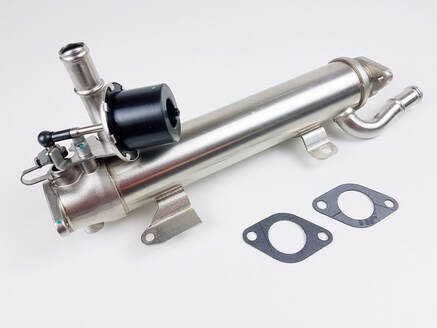Part 1 – Why and How By P Sanchez I find that one of the most interesting and often times misunderstood component of the modern engine is the Exhaust Gas Recirculation or EGR system. Fitted in most gasoline and diesel engines since the ’70s to meet emission standards, it’s an emission control system that lowers nitrous oxide byproduct in engine exhaust. It does this by “recirculating back some of the exhaust into the intake which helps reduce combustion temperatures.” Wait, what? Isn’t exhaust hot in the first place? And isn’t nitrous oxide the same as “NOS”, that tank of special gas that racer boy types install on their heavily modded cars to make them go crazy-fast? But why some people think EGR is a performance-limiting device to put-up with? So many questions. It took some digging on my end to demystify the deceptively simple but ingenious EGR system which I will share with you in this installment of the Auto Repair Blog and hopefully it’ll clear up some of the smoke. No to NOS
Nitrous oxide (NOx) is more commonly known as “Laughing Gas”, a dental anesthetic that blocks pain, sedates and causes euphoric behavior when inhaled in sufficient quantities. You’d think that’s something you’d welcome when you’re stuck in dreary traffic, but long term exposure to NOx cause mental impairment, nerve and brain damage. But the worst thing about NOx is that it’s a greenhouse gas, in fact, one of the worst offenders. Several studies (like this and this) have shown that although NOx accounts only 6% of the total composition of vehicular emission (with carbon dioxide accounting the most at 82%), NOx has 300 times more global warming potential than carbon dioxide, and it also damages the ozone layer. And when the transportation sector has been shown as the biggest contributor of greenhouse gases (which includes NOx) at 29% - more than electricity production or the industrial sector – implementation of policy to curb vehicular emissions becomes no laughing matter. The primary components of NOx are what air is primarily made of nitrogen and oxygen. While oxygen is needed in most chemical processes like fuel combustion, nitrogen itself is a relatively inert gas under normal atmospheric conditions. But in the extreme environment within the cylinders of an automobile engine, high heat and pressure make fuel-air reacts violently during the combustion process and you get NOx as one of the unwanted byproducts. And sure, catalytic converters can take care most of the NOx, further breaking down the chemical (to see how a cat works, read our previous article here) but a not so insignificant percentage still escapes into the atmosphere. Plus, cats can only work effectively with gasoline engines but are unsuitable for diesel. Diesel engines not only give out higher quantities of NOx due to their higher operating heat and pressure but also higher quantities of particulate matter like soot (carbon dioxide) which can clog the fine honey-comb filter material of a cat. It’s All Science and All Relative. To reduce the creation of NOx, engineers needed to control either pressure or the heat created in the combustion process. They found that re-introducing to the intake mix some of the exhaust gas, which is basically spent or non-reactive gas (“inert”), does the trick. The inert gas takes the place of some of the fresh air (around 5 to 15%) and with constant adjustment of the engine with the air and fuel ratio, makes the fuel-air mix a tad less combustible. This reduces the incidence of extreme high-heat during the initial ignition, tempers the combustion of the fuel-air mix, and dialing back on the production of the undesirable gas. But wait. Less fresh air, less heat... Sounds like less power. Why would you want that? It’s true, the net effect of adding exhaust in the intake is akin to reducing the size of the effective volume of the cylinder. But one of the common misconceptions about the EGR system is it’s on all the time. It’s not. The system only kicks in during low rev and low load scenarios, when power is not needed, and at the other end of the performance spectrum, high revs or high charge scenarios (like in forced inductions) when the risk of engine knock is highest. So the EGR system adds additional protection against engine detonation. Next Time So we’ve just talked about how, in particular scenarios, an EGR system can make the engine favorably less thermally efficient. Next time, we’ll discuss another EGR curveball: it can increase an engine’s overall operational efficiency (What now??). Yes, it does! So stay tuned. What can you say about the EGR system? A necessary engine management technology or just something to appease environmental regulations? We’d like to know your opinion by leaving comments below.
0 Comments
Leave a Reply. |
AuthorSmith's Auto Repair serves Dayton, Ohio and the surrounding communities using digital inspection service for all its customers ArchivesCategories |
 RSS Feed
RSS Feed